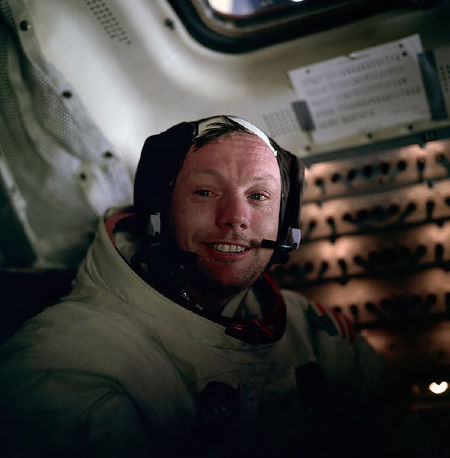Neil Alden Armstrong, the first man from Earth to set foot upon the Moon, departed from this life on Saturday, 25 August 2012. A native of Wapakoneta, Ohio, Armstrong spent 82 years in mortality.
Flight, both in the air and in space, was a major focus of Neil Armstrong’s life. He served in the Korean War as a Naval Aviator. Later, Armstrong saw duty as an experimental research test pilot for the National Advisory Committee For Aeronautics (NACA) and the National Aeronautics and Astronautics Administration (NASA). His exploits as an astronaut, first with the Gemini Program and then with Project Apollo, are well known.
A licensed pilot by age 15, Neil Armstrong flew many different types of aircraft. A short list includes the F9F Panther, all of the Century Series aircraft (with the possible exception of the F-102 Delta Dagger), the B-47 Stratojet and the KC-135 Stratotanker. Armstrong also piloted the Bell X-1, the Bell X-5 and North American X-15 flight research aircraft.
Armstrong was quite accustomed to danger and experienced a number of life-endangering situations while in flight These include a wartime ejection from a stricken aircraft, overshooting Edwards AFB by 45 miles while flying the X-15, the Gemini VIII emergency in space and a harrowing last second ejection from a faulty Lunar Landing Research Vehicle (LLRV). Each time danger threatened, Armstrong was equal to the challenge and lived to fly another day.
In addition to being a pilot and astronaut, Neil Armstrong was an engineer. His educational attainments included degrees in aeronautical engineering from Purdue University (bachelor of science, 1955) and the University of Southern California (masters of science, 1970). After leaving NASA in 1971, Armstrong served for 8 years as a professor of aerospace engineering at the University of Cincinnati.
Armstrong was the recipient of many awards and accolades during his life. Primary among such were the Presidential Medal of Freedom, Congressional Space Medal of Honor and the Congressional Gold Medal. He also received the Langley Gold Medal, the Robert H. Goddard Memorial Trophy, the Sylvanus Thayer Award, and the Collier Trophy. Neil Armstrong was also an inductee of the Aerospace Walk of Honor and the United States Astronaut Hall of Fame.
Neil Armstrong was the subject of much notoreity as a result of the pivotal role he played in the Apollo 11 lunar landing of July 1969. As the first man from Earth to walk upon the Moon, his name will be forever linked with that epic event. However, Armstrong was neither a man of the limelight nor desirous of being a public figure in any way. Intensely private, he participated in relatively few social settings which would subject him to public scrutiny or interaction. This peculiar personal trait, which he manifested to the end of his life, mystified many and rankled some.
For many of us who were around forty-three (43) summers ago when Neil Armstrong stepped off the Lunar Module Eagle onto the lunar surface at the Sea of Tranquility, his passing is a particularly poignant moment in the history of our lives. Why is that? That we miss him is beyond question. But, that is not really the core of the matter. We will see him again. Just as we will see all those who have passed beyond the veil when it is our turn to depart from mortality.
Rather, the poignancy that we feel stems from where we now find ourselves as a spacefaring nation. Individuals like Neal Armstrong have bequeathed to us a priceless heritage in the realm of spaceflight. That heritage now languishes in a backwater of national complacency, purposeless and lack of vision.
We cannot go the Moon as Neil Armstrong and others once did. The Space Shuttle is gone. We do not even have a spacecraft or a launch vehicle to get to our own space station now orbiting the Earth. We must pay another country $63,000,000 per seat just to get there and back. While we mourn Neil Armstrong’s passing, we mourn even more for that which once was and now is not. Our mourning is made more profound by the realization that we have only ourselves to blame.
The family of Neil Armstrong has requested that we remember him and give him a wink every time we look up at the Moon. Perhaps we should also take a moment and reflect upon what he and other space explorers accomplished as well as the path that they set before us. As we do so, maybe we should hang our heads a bit for the callous treatment of what they left us for safe keeping.


